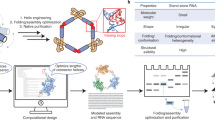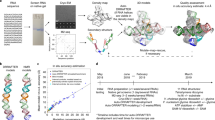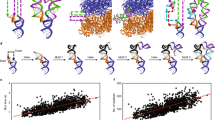Abstract
More than 50% of RNA secondary structure is estimated to be A-form helices, which are linked together by various junctions. Here we describe a protocol for computing three interhelical Euler angles describing the relative orientation of helices across RNA junctions. 5′ and 3′ helices, H1 and H2, respectively, are assigned based on the junction topology. A reference canonical helix is constructed using an appropriate molecular builder software consisting of two continuous idealized A-form helices (iH1 and iH2) with helix axis oriented along the molecular Z-direction running toward the positive direction from iH1 to iH2. The phosphate groups and the carbon and oxygen atoms of the sugars are used to superimpose helix H1 of a target interhelical junction onto the corresponding iH1 of the reference helix. A copy of iH2 is then superimposed onto the resulting H2 helix to generate iH2′. A rotation matrix R is computed, which rotates iH2′ into iH2 and expresses the rotation parameters in terms of three Euler angles αh, βh and γh. The angles are processed to resolve a twofold degeneracy and to select an overall rotation around the axis of the reference helix. The three interhelical Euler angles define clockwise rotations around the 5′ (−γh) and 3′ (αh) helices and an interhelical bend angle (βh). The angles can be depicted graphically to provide a 'Ramachandran'-type view of RNA global structure that can be used to identify unusual conformations as well as to understand variations due to changes in sequence, junction topology and other parameters.
This is a preview of subscription content, access via your institution
Access options
Subscribe to this journal
Receive 12 print issues and online access
$259.00 per year
only $21.58 per issue
Buy this article
- Purchase on Springer Link
- Instant access to full article PDF
Prices may be subject to local taxes which are calculated during checkout





Similar content being viewed by others
References
Hooft, R.W., Sander, C. & Vriend, G. Objectively judging the quality of a protein structure from a Ramachandran plot. Comput. Appl. Biosci. 13, 425–430 (1997).
Bertini, I., Cavallaro, G., Luchinat, C. & Poli, I. A use of Ramachandran potentials in protein solution structure determinations. J. Biomol. NMR 26, 355–366 (2003).
Gopalakrishnan, K., Sheik, S.S., Ranjani, C.V., Udayakumar, A. & Sekar, K. Conformational Angles DataBase (CADB-3.0). Prot. Pept. Lett. 14, 665–668 (2007).
Wu, D., Jernigan, R. & Wu, Z. Refinement of NMR-determined protein structures with database derived mean-force potentials. Proteins 68, 232–242 (2007).
Kumar, M.V. & Swaminathan, R. A novel approach to segregate and identify functional loop regions in protein structures using their Ramachandran maps. Proteins 78, 900–916 (2010).
MacDonald, J.T., Maksimiak, K., Sadowski, M.I. & Taylor, W.R. De novo backbone scaffolds for protein design. Proteins 78, 1311–1325 (2010).
Olson, W.K. et al. A standard reference frame for the description of nucleic acid base-pair geometry. J. Mol. Biol. 313, 229–237 (2001).
Neidle, S. Oxford Handbook of Nucleic Acid Structure (Oxford University Press, 1999).
Duarte, C.M. & Pyle, A.M. Stepping through an RNA structure: a novel approach to conformational analysis. J. Mol. Biol. 284, 1465–1478 (1998).
Chu, V.B. et al. Do conformational biases of simple helical junctions influence RNA folding stability and specificity? RNA 15, 2195–2205 (2009).
Koch, M.H., Vachette, P. & Svergun, D.I. Small-angle scattering: a view on the properties, structures and structural changes of biological macromolecules in solution. Q. Rev. Biophys. 36, 147–227 (2003).
Patkowski, A., Eimer, W. & Dorfmüller, T. Internal dynamics of tRNA(Phe) studied by depolarized dynamic light scattering. Biopolymers 30, 975–983 (1990).
Anunciado, D. et al. Characterization of the dynamics of an essential helix in the U1A protein by time-resolved fluorescence measurements. J. Phys. Chem. B. 112, 6122–6130 (2008).
Cherny, D.I., Eperon, I.C. & Bagshaw, C.R. Probing complexes with single fluorophores: factors contributing to dispersion of FRET in DNA/RNA duplexes. Eur. Biophys. J. 38, 395–405 (2009).
Leontis, N.B. & Westhof, E. Geometric nomenclature and classification of RNA base pairs. RNA 7, 499–512 (2001).
Bhattacharyya, A., Murchie, A. & Lilley, D.M. RNA bulges and the helical periodicity of double-stranded RNA. Nature 343, 484–487 (1990).
Lilley, D.M. Folding of branched RNA species. Biopolymers 48, 101–112 (1998).
Goody, T.A., Lilley, D.M. & Norman, D.G. The chirality of a four-way helical junction in RNA. J. Am. Chem. Soc. 126, 4126–4127 (2004).
Musselman, C. et al. Impact of static and dynamic A-form heterogeneity on the determination of RNA global structural dynamics using NMR residual dipolar couplings. J. Biomol. NMR 36, 235–249 (2006).
Gast, F.U., Amiri, K.M. & Hagerman, P.J. Interhelix geometry of stems I and II of a self-cleaving hammerhead RNA. Biochemistry 33, 1788–1796 (1994).
Leehey, M.A., Squassoni, C.A., Friederich, M.W., Mills, J.B. & Hagerman, P.J. A noncanonical tertiary conformation of a human mitochondrial transfer RNA. Biochemistry 34, 16235–16239 (1995).
Zacharias, M. & Hagerman, P.J. Bulge-induced bends in RNA: quantification by transient electric birefringence. J. Mol. Biol. 247, 486–500 (1995).
Zacharias, M. & Hagerman, P.J. The influence of symmetric internal loops on the flexibility of RNA. J. Mol. Biol. 257, 276–289 (1996).
Zacharias, M. & Hagerman, P.J. Influence of static and dynamic bends on the birefringence decay profile of RNA helices: Brownian dynamics simulations. Biophys. J. 73, 318–332 (1997).
Nakamura, T.M., Wang, Y.H., Zaug, A.J., Griffith, J.D. & Cech, T.R. Relative orientation of RNA helices in a group 1 ribozyme determined by helix extension electron microscopy. EMBO J. 14, 4849 (1995).
Amiri, K.M.A. & Hagerman, P.J. Global conformation of a self-cleaving hammerhead RNA. Biochemistry 33, 13172–13177 (1994).
Al-Hashimi, H.M. et al. Concerted motions in HIV-1 TAR RNA may allow access to bound state conformations: RNA dynamics from NMR residual dipolar couplings. J. Mol. Biol. 315, 95–102 (2002).
Zhang, Q., Sun, X., Watt, E.D. & Al-Hashimi, H.M. Resolving the motional modes that code for RNA adaptation. Science 311, 653–656 (2006).
Hansen, A.L. & Al-Hashimi, H.M. Dynamics of large elongated RNA by NMR carbon relaxation. J. Am. Chem. Soc. 129, 16072–16082 (2007).
Zhang, Q., Stelzer, A.C., Fisher, C.K. & Al-Hashimi, H.M. Visualizing spatially correlated dynamics that directs RNA conformational transitions. Nature 450, 1263–1267 (2007).
Getz, M.M., Andrews, A.J., Fierke, C.A. & Al-Hashimi, H.M. Structural plasticity and Mg2+ binding properties of RNase P P4 from combined analysis of NMR residual dipolar couplings and motionally decoupled spin relaxation. RNA 13, 251–266 (2007).
Zhang, Q. & Al-Hashimi, H.M. Extending the NMR spatial resolution limit for RNA by motional couplings. Nat. Methods 5, 243–245 (2008).
Hansen, A.L., Nikolova, E.N., Casiano-Negroni, A. & Al-Hashimi, H.M. Extending the range of microsecond-to-millisecond chemical exchange detected in labeled and unlabeled nucleic acids by selective carbon R(1rho) NMR spectroscopy. J. Am. Chem. Soc. 131, 3818–3819 (2009).
Zhang, Q. & Al-Hashimi, H.M. Domain-elongation NMR spectroscopy yields new insights into RNA dynamics and adaptive recognition. RNA 15, 1941–1948 (2009).
Dethoff, E.A., Hansen, A.L., Zhang, Q. & Al-Hashimi, H.M. Variable helix elongation as a tool to modulate RNA alignment and motional couplings. J. Magn. Reson. 202, 117–121 (2010).
Bax, A. & Grishaev, A. Weak alignment NMR: a hawk-eyed view of biomolecular structure. Curr. Opin. Struct. Biol. 15, 563–570 (2005).
Lipsitz, R.S. & Tjandra, N. Residual dipolar couplings in NMR structure analysis. Annu. Rev. Biophys. Biomol. Struct. 33, 387–413 (2004).
MacDonald, D. & Lu, P. Residual dipolar couplings in nucleic acid structure determination. Curr. Opin. Struct. Biol. 12, 337–343 (2002).
Casiano-Negroni, A., Sun, X. & Al-Hashimi, H.M. Probing Na(+)-induced changes in the HIV-1 TAR conformational dynamics using NMR residual dipolar couplings: new insights into the role of counterions and electrostatic interactions in adaptive recognition. Biochemistry 46, 6525–6535 (2007).
Getz, M., Sun, X., Casiano-Negroni, A., Zhang, Q. & Al-Hashimi, H.M. NMR studies of RNA dynamics and structural plasticity using NMR residual dipolar couplings. Biopolymers 86, 384–402 (2007).
Bailor, M.H. et al. Characterizing the relative orientation and dynamics of RNA A-form helices using NMR residual dipolar couplings. Nat. Protoc. 2, 1536–1546 (2007).
Bailor, M.H., Sun, X. & Al-Hashimi, H.M. Topology links RNA secondary structure with global conformation, dynamics, and adaptation. Science 327, 202–206 (2010).
Gelbin, A. et al. Geometric parameters in nucleic acids: sugar and phosphate constituents. J. Am. Chem. Soc. 118, 519–529 (1996).
Nelson, J.W., Martin, F.H. & Tinoco, I. DNA and RNA oligomer thermodynamics: the effect of mismatched bases on double-helix stability. Biopolymers 20, 2509–2531 (1981).
Holbrook, S.R. & Kim, S.H. Local mobility of nucleic acids as determined from crystallographic data. I. RNA and B form DNA. J. Mol. Biol. 173, 361–388 (1984).
Foloppe, N. & MacKerell, A.D. Jr. Conformational properties of the deoxyribose and ribose moieties of nucleic acids: a quantum mechanical study. J. Phys. Chem. B. 102, 6669–6678 (1998).
Lilley, D.M. et al. A nomenclature of junctions and branchpoints in nucleic acids. Nucleic Acids Res. 23, 3363–3364 (1995).
Yang, H. et al. Tools for the automatic identification and classification of RNA base pairs. Nucleic Acids Res. 31, 3450–3460 (2003).
Varshalovich, D.A., Moskalev, A.N. & Khersonskii, V.K. Quantum Theory of Angular Momentum (World Scientific Pub. Co., 1987).
Tolman, J.R., Al-Hashimi, H.M., Kay, L.E. & Prestegard, J.H. Structural and dynamic analysis of residual dipolar coupling data for proteins. J. Am. Chem. Soc. 123, 1416–1424 (2001).
Fisher, C.K. & Al-Hashimi, H.M. Approximate reconstruction of continuous spatially complex domain motions by multialignment NMR residual dipolar couplings. J. Phys. Chem. B. 113, 6173–6176 (2009).
Bugayevskiy, L.M. & Snyder, J.P. Map Projections: A Reference Manual (Blackwell Publishers, 1996).
Losonczi, J.A., Andrec, M., Fischer, M.W.F. & Prestegard, J.H. Order matrix analysis of residual dipolar couplings using singular value decomposition. J. Mag. Reson. 138, 334–342 (1999).
Jossinet, F., Ludwig, T.E. & Westhof, E. Assemble: an interactive graphical tool to analyze and build RNA architectures at the 2D and 3D levels. Bioinformatics 26, 2057–2059 (2010).
Ravishanker, G., Swaminathan, S., Beveridge, D.L., Lavery, R. & Sklenar, H. Conformational and helicoidal analysis of 30 PS of molecular dynamics on the d (CGCGAATTCGCG) double helix: 'curves', dials and windows. J. Biomol. Struct. Dyn. 6, 669–699 (1989).
Dickerson, R.E. DNA bending: the prevalence of kinkiness and the virtues of normality. Nucleic Acids Res. 26, 1906–1926 (1998).
Lu, X.J. & Olson, W.K. 3DNA: a software package for the analysis, rebuilding and visualization of three-dimensional nucleic acid structures. Nucleic Acids Res. 31, 5108–5121 (2003).
Lu, X.J., El Hassan, M.A. & Hunter, C.A. Structure and conformation of helical nucleic acids: analysis program (SCHNAaP). J. Mol. Biol. 273, 668–680 (1997).
Bansal, M., Bhattacharyya, D. & Ravi, B. NUPARM and NUCGEN: software for analysis and generation of sequence dependent nucleic acid structures. Comput. Appl. Biosci. 11, 281–287 (1995).
Ren, P. & Ponder, J.W. Consistent treatment of inter- and intramolecular polarization in molecular mechanics calculations. J. Comput. Chem. 23, 1497–1506 (2002).
Acknowledgements
We thank D. Herschlag and V. Chu of Stanford University for stimulating discussions. A.M.M. acknowledges support from a Graduate Research Fellowship from the National Science Foundation (NSF). H.M.A.-H. acknowledges support from a NSF CAREER award (MCB 0644278) and a National Institutes of Health grant (R01GM089846). C.L.B. acknowledges funding for the Center for Multi-scale Modeling Tools for Structural Biology by the National Center for Research Resources (P41RR012255).
Author information
Authors and Affiliations
Contributions
All authors contributed to the work presented in this paper. M.H.B. and H.M.A.-H. conceived the original protocol, developed the underlying theory and performed the analysis. A.M.M. developed theory and performed analysis to define the various Euler angle conventions, improve the robustness of the protocol and establish its limits of applicability. C.L.B. performed supporting simulations to assess the robustness of the protocol. M.H.B., A.M.M., C.L.B. and H.M.A.-H. prepared the manuscript.
Corresponding author
Ethics declarations
Competing interests
The authors declare no competing financial interests.
Rights and permissions
About this article
Cite this article
Bailor, M., Mustoe, A., Brooks, C. et al. 3D maps of RNA interhelical junctions. Nat Protoc 6, 1536–1545 (2011). https://doi.org/10.1038/nprot.2011.385
Published:
Issue Date:
DOI: https://doi.org/10.1038/nprot.2011.385
This article is cited by
-
DNA mismatches reveal conformational penalties in protein–DNA recognition
Nature (2020)
-
Rapid and accurate determination of atomistic RNA dynamic ensemble models using NMR and structure prediction
Nature Communications (2020)
-
High-performance virtual screening by targeting a high-resolution RNA dynamic ensemble
Nature Structural & Molecular Biology (2018)
-
Measuring similarity between dynamic ensembles of biomolecules
Nature Methods (2014)
Comments
By submitting a comment you agree to abide by our Terms and Community Guidelines. If you find something abusive or that does not comply with our terms or guidelines please flag it as inappropriate.



